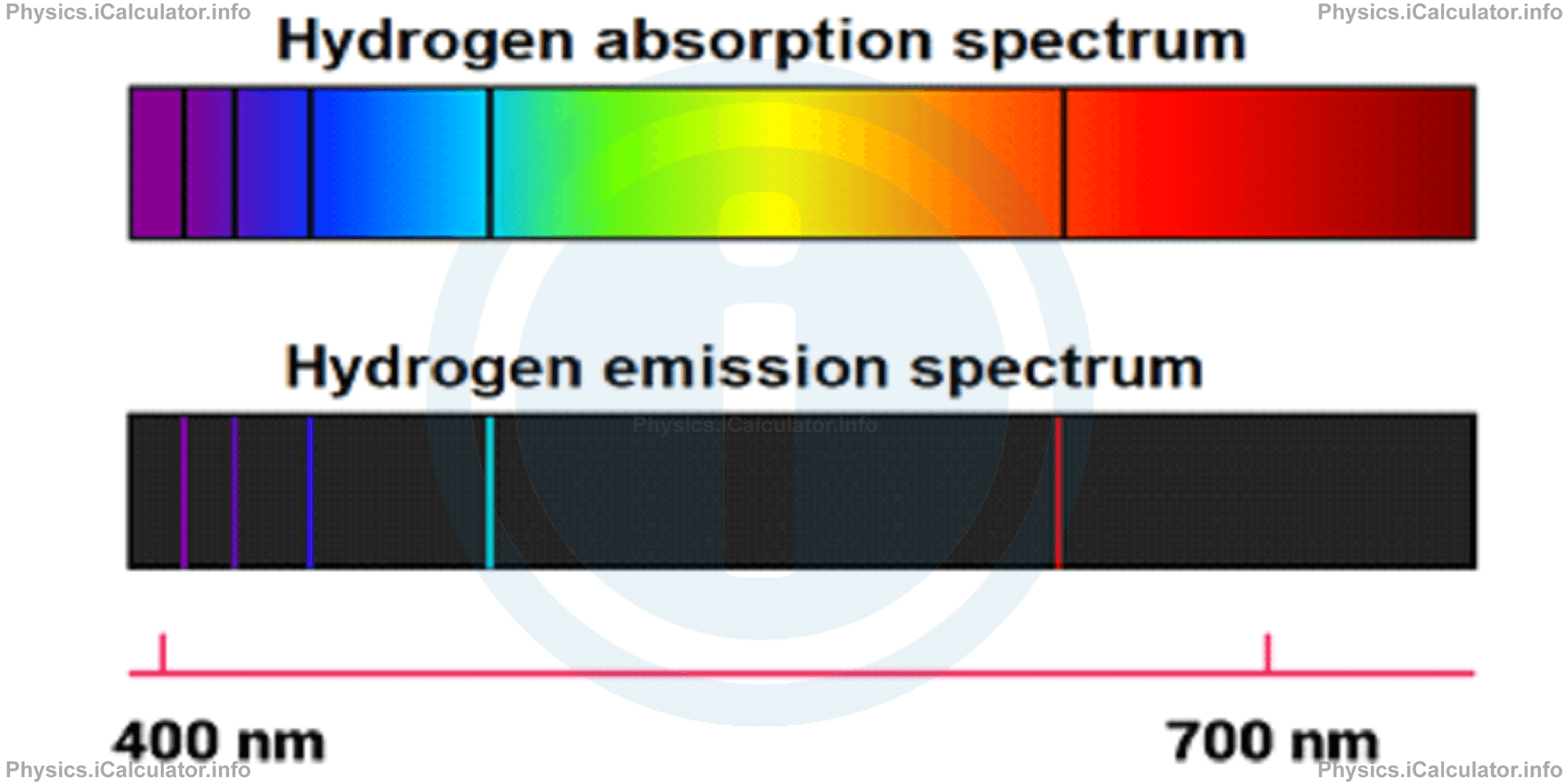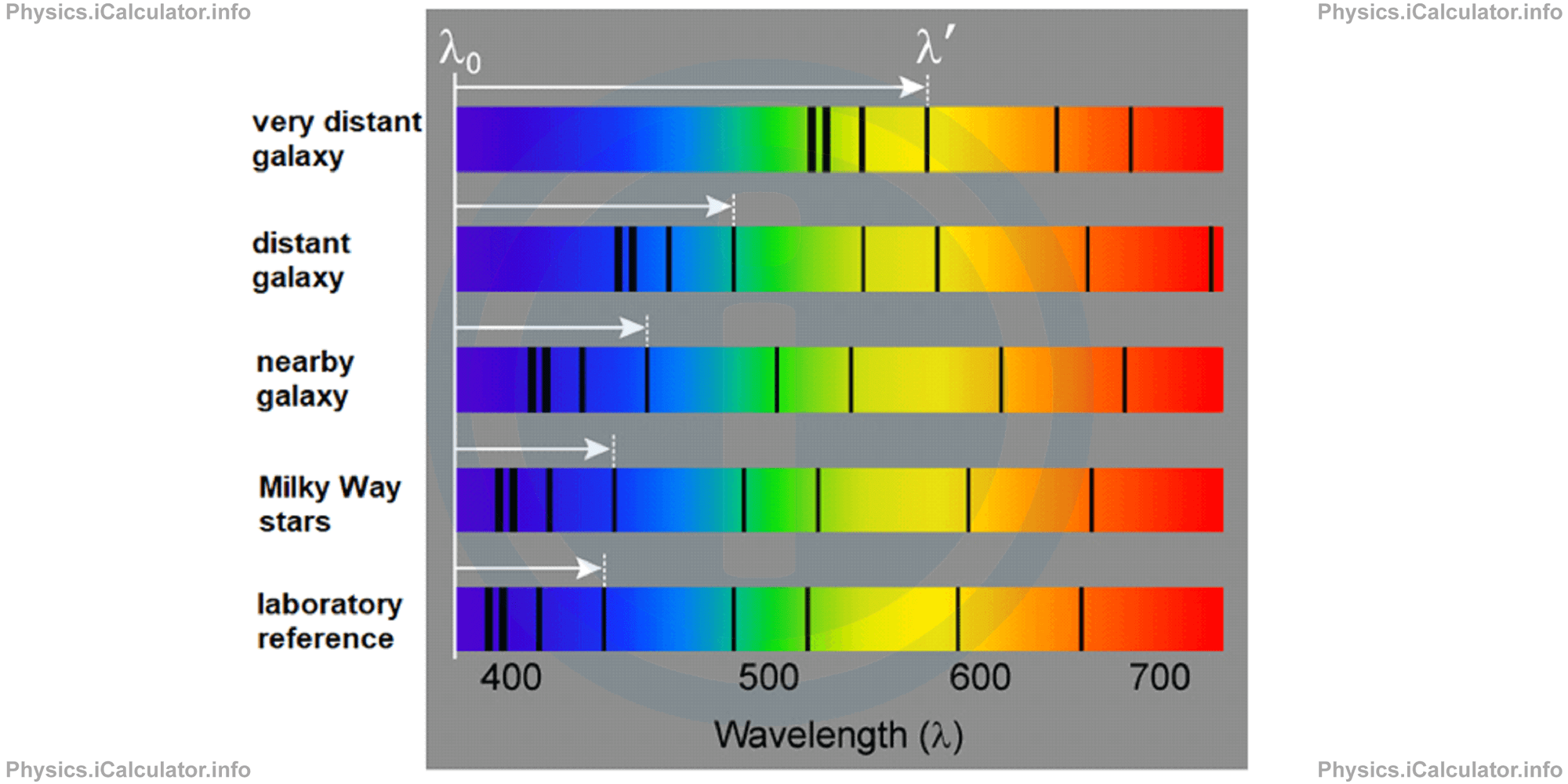Menu
Physics Lesson 22.9.2 - Spectra of Chemical Elements in Remote Galaxies and the Doppler Effect
Please provide a rating, it takes seconds and helps us to keep this resource free for all to use
Welcome to our Physics lesson on Spectra of Chemical Elements in Remote Galaxies and the Doppler Effect, this is the second lesson of our suite of physics lessons covering the topic of Expansion of the Universe, you can find links to the other lessons within this tutorial and access additional physics learning resources below this lesson.
Spectra of Chemical Elements in Remote Galaxies and the Doppler Effect
In the previous section, we discovered that stars are mostly consist of hydrogen and helium, where hydrogen is the overwhelming element involved in thermonuclear reactions of fusion. They radiate EM waves in different wavelengths that depend on the processes in which hydrogen atoms are involved. When a hydrogen atom is excited, it returns to its original (unexcited) state by radiating the extra energy it has absorbed. This energy is emitted or absorbed by the hydrogen atom in specific wavelengths known as atomic spectra. They appear as vertical parallel lines in diagrams (and in detecting devices called spectroscopes) where the horizontal axis shows the values of wavelength emitted. This phenomenon occurs when an electron jumps from one energetic level (orbit) to another. The spectral series produced are characteristic of the atoms emitting them.

While analysing the light emitted from various celestial bodies, scientists detected spectral lines of radiation and absorption rates similar to those of elements found on Earth. The only difference is that these spectral lines have slightly lower frequencies (therefore longer wavelengths) from those measured in Earth conditions. The following figure shows the shift in spectral lines of hydrogen measured on Earth and beyond.

You can see that in remote galaxies the wavelengths of hydrogen spectral lines shift towards longer wavelengths (or shorter frequencies). Hence, these results obtained experimentally contradict the idea of Universe homogeneity because in different parts of the Universe chemical elements show different properties.
The explanation of this phenomenon is very simple considering what we have already discussed in tutorial 12.7 on Doppler Effect of light and Red Shift. We have explained that when a light source is moving away from the observer, the frequency decreases (that is wavelength increases), making the spectral lines emitted by radiating hydrogen atoms shift towards the red colour. We have explained that the equation of frequencies in Doppler Effect is
where β = v/c (v is the speed of light source and c the speed of light in vacuum). This formula is true for light sources moving away from a stationary observer. The original frequency of EM waves emitted by the source is denoted as f0 and the frequency detected by any stationary observer on Earth is f.
The above formula shows that when a light source is moving away from a stationary observer, the frequency detected by the observer is smaller than the original frequency emitted by the source. (We take all observers on Earth as stationary. This is because even, if they are somehow moving [for example all us rotate along with the Earth around its axis or revolve around the Sun], their speed is much smaller when compared to the speed of light). As a result, the wavelength of EM radiation detected on Earth is larger than the original one. Hence, there is a shift towards the red spectrum of visible light (red colour has a longer characteristic wavelength than the other colours of visible spectrum). We therefore obtain the phenomenon of red-shift, which is a proof that the Universe is expanding because this phenomenon is observed only in remote galaxies, not in nearby ones.
If a galaxy is approaching ours, the opposite phenomenon of red-shift (known as blue-shift) occurs. Such phenomenon results in an increase in light frequency (a decrease in wavelength therefore) towards the blue colour of visible spectrum. The corresponding formula of blue-shift is
Since blue-shift occurs is a local phenomenon, we cannot generalize and consider it as a norm, unlike red-shift, which occurs in all remote galaxies. Hence, nowadays it is a confirmed fact that the Universe is actually expanding.
Example 1
One of the hydrogen spectral lines detected from a remote galaxy has a wavelength of 534.7 nm. When the same spectral line is analysed in lab conditions on Earth, it results that its detected wavelength is 486.1 nm. Calculate the speed at which the remote galaxy is moving away from us.
Solution 1
Clues:
λ0 = 486.1 nm = 4.861 × 10-7 m
(c = 3 × 108 m/s)
v = ?
First, we have to calculate the corresponding frequencies given the wavelengths. We use the equation of light waves c = λ · f for this purpose. We have
= 3 × 108 m/s/5.347 × 10-7 m
= 5.61 × 1014 Hz
and
= 3 × 108 m/s/4.861 × 10-7 m
= 6.17 × 1014 Hz
We have to use the formula of red-shift as the remote galaxies move away from us. We have
f = f0 ∙ √1 - v/c/1 + v/c
Raising both sides at the power two to isolate v, we obtain
f2/f20 = 1 - v/c/1 + v/c
f2/f20 ∙ (1 + v/c) = 1 - v/c
f2/f20 + f2/f20 ∙ v/c = 1 - v/c
f2/f20 ∙ v/c + v/c = 1 - f2/f20
v/c ∙ (f2/f20 + 1) = 1 - f2/f20
v/c = 1 - f2/f20/f2/f20 + 1
v = 1 - f2/f20/1 + f2/f20 ∙ c
For convenience, we can simplify the powers of ten in the values of frequencies. Hence, we have
= (1 - 0.8267/1 + 0.8267) ∙ (3 × 108 m/s)
= (0.1733/1.8267) ∙ (3 × 108 m/s)
= 2.8461 × 107 m/s
= 28.461 million m/s
This value is more than 10 times lower than the speed of light (about 300 million m/s) and therefore, the solution does not violate the laws of physics.
You have reached the end of Physics lesson 22.9.2 Spectra of Chemical Elements in Remote Galaxies and the Doppler Effect. There are 6 lessons in this physics tutorial covering Expansion of the Universe, you can access all the lessons from this tutorial below.
More Expansion of the Universe Lessons and Learning Resources
Whats next?
Enjoy the "Spectra of Chemical Elements in Remote Galaxies and the Doppler Effect" physics lesson? People who liked the "Expansion of the Universe lesson found the following resources useful:
- Spectra Feedback. Helps other - Leave a rating for this spectra (see below)
- Cosmology Physics tutorial: Expansion of the Universe. Read the Expansion of the Universe physics tutorial and build your physics knowledge of Cosmology
- Cosmology Revision Notes: Expansion of the Universe. Print the notes so you can revise the key points covered in the physics tutorial for Expansion of the Universe
- Cosmology Practice Questions: Expansion of the Universe. Test and improve your knowledge of Expansion of the Universe with example questins and answers
- Check your calculations for Cosmology questions with our excellent Cosmology calculators which contain full equations and calculations clearly displayed line by line. See the Cosmology Calculators by iCalculator™ below.
- Continuing learning cosmology - read our next physics tutorial: Big Bang Model and Temperature
Help others Learning Physics just like you
Please provide a rating, it takes seconds and helps us to keep this resource free for all to use
We hope you found this Physics lesson "Expansion of the Universe" useful. If you did it would be great if you could spare the time to rate this physics lesson (simply click on the number of stars that match your assessment of this physics learning aide) and/or share on social media, this helps us identify popular tutorials and calculators and expand our free learning resources to support our users around the world have free access to expand their knowledge of physics and other disciplines.